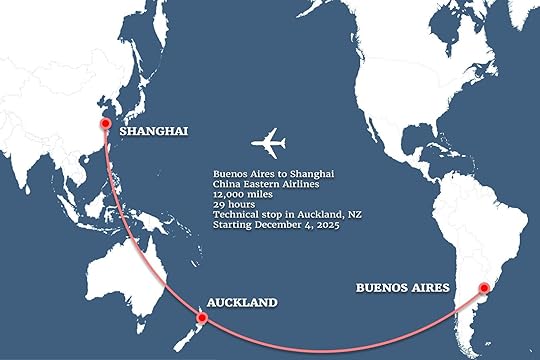29 Hours, 12,200 Miles: the New Longest Direct Flight in the World

The commercial aviation industry has come a long way since the introduction of jet passenger service in the 1950s, and in 2025, it’s hitting another milestone: there’s about to be a new longest direct flight in the world.
The flight was first announced in June 2025, when China Eastern and Auckland Airport signed an agreement in Shanghai, which was covered by official news sources at the time. It hadn’t yet been approved by regulatory agencies, and no flight time was given, though news coverage did note that it would significantly shorten travel time by creating a more direct route.
Now, China Eastern has opened the flight for booking, and one thing is clear: travelers should be sure to pack a phone charger, because at 29 hours, the route is about to become the longest direct flight in the world.

Photo: Matador Network
The new route will begin flying on December 4, 2025, connecting Shanghai, China, to Buenos Aires, Argentina. It will be the first direct air link between China and Argentina, and the only nonstop option between Shanghai and any South American destination. While it will be the longest direct flight in the world, it’s not the longest nonstop flight in the world, as it makes a two-hour stopover in Auckland, New Zealand. It qualifies as “direct” because passengers remain onboard the same Boeing 777-300ER under a single flight number, and aren’t able to exit the plane in Auckland.
While the trip from Buenos Aires to Shanghai is a bit shorter due to predictable tailwinds, at just over 25 hours, the trip to Buenos Aires will cover roughly 12,200 miles during a 29-hour trip. It surpasses Air China’s Beijing, China to São Paulo, Brazil service (with a stop in Madrid, Spain), as the world’s longest direct flight. Singapore Airlines’ nonstop New York-to-Singapore service still holds the record for the longest nonstop route in the world, at about 19 hours.

The new route will be flown on Boeing 777s. Photo: MihailC95/Shutterstock
Before this flight, travelers moving between the two cities would have to make time-consuming connections in Europe or North America. Even at 29 hours, the new flight will cut at least five hours off the fastest itineraries currently available. While it’s flyers who will appreciate the saved hours, the route is also expected to be used for imports and exports, as China is a huge importer of Argentinian beef and soy.

Having a proper sleep plan will be key to feeling rested when you land, especially at China Eastern doesn’t provide many sleep- or comfort-related amenities in Economy class. Photo: Matej Kastelic/Shutterstock
The new route will be the quickest between the two cities, but spending nearly 30 hours on board a single aircraft, even with a short break in Auckland, is still bound to be stressful. Flying in Business Class will likely make it slightly more bearable, but premium class seats are expected to start around at least $5,000, as opposed to about $1,500 in Economy.
The route will be flown on a Boeing 777-300ER, which seats 316 travelers. It’ll be essential to manage hydration, blood flow, and jet lag on board, especially given the 11-hour time difference between the two cities. Travelers flying to Shanghai will depart in the evening and arrive two calendar days later, effectively losing a day. Flyers headed to Buenos Aires will “gain” half a day. While this maximizes your time in the destination, it can be hard to stay awake into the evening, especially if you’ve not slept on the flight. As of now, China Eastern doesn’t have any on-board amenities available to all passengers to help with the jet lag, akin to the “wellness stations” offered by airlines like Qantas.

Travelers headed to Buenos Aires should try to stay awake for the rest of the day after landing. Photo: Mariano Colombotto/Shutterstock
If you’re headed to Buenos Aires (the longer way), try to stay awake for the first few hours, then get six or seven hours of sleep that line up with nighttime in Shanghai. After the Auckland stop, stay awake for a while, then aim for another four or five hours of rest during Buenos Aires’ early morning. You’ll land in the early afternoon local time. Resist the urge to nap until evening to help your body clock adjust.
If you’re flying to Shanghai (the shorter direction), try to sleep soon after takeoff and wake up around what would be morning in Shanghai. Stay awake as much as possible for the rest of the journey (a short nap before landing is fine), then push through until nighttime in Shanghai to reset more quickly. Websites like Sleepopolis or Phyllola or apps like TimeShifter can help you plan more detailed sleep schedules to beat jet lag as much as possible.

A rendering of the First Class suites on Qantas’ new “Project Sunrise” flights. Photo: Qantas
The China Eastern flight is extra-long because of the stopover in Auckland. When it comes to nonstop flights, the longest theoretical flight in the world (though it’s not currently possible with today’s planes) would be something like Auckland, New Zealand, to Seville, Spain; or Madrid, Spain, to Wellington, New Zealand. At 560 miles per hour (about the typical speed of today’s large planes), each of those routes would take just over 22 hours, beating the current Singapore Airlines record.
While those routes aren’t possible (yet), Qantas did announce in May 2022 that it was reviving plans for “Project Sunrise:” nonstop long-haul flights between Sydney and far-flung locations like New York and London. It’ll be flown on planes modified to have a higher fuel capacity, with routes taking an estimated 20-22 hours. Those flights are expected to launch in early-to-mid 2027, with Qantas planning to dedicate about 40 percent of the 238 seats on board to First, Business, and Premium Economy. 
Matador Network's Blog
- Matador Network's profile
- 6 followers



